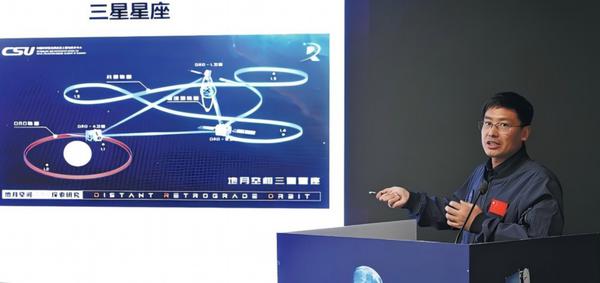 |
 |
 |
 |
 |
 |
 |
 |
 |
 |  |
 |
 |
 |
 |
 |
 |
 |
 |
 |
 |
 |
 |
 Wang Wenbin, a researcher of Chinese Academy of Sciences, introduces a project on the exploration of the distant retrograde orbit of the Earth-moon system at an academic symposium in Beijing on Monday. (SUN ZIFA/CHINA NEWS SERVICE) China has successfully deployed the world's first three-satellite constellation on the distant retrograde orbit of the Earth-moon system, marking a milestone in the country's deep-space exploration capabilities, scientists announced at an academic symposium in Beijing on Monday. The DRO-A/B satellites, developed under the Chinese Academy of Sciences' priority research program "DRO Exploration", recently linked with the previously launched DRO-L satellite in low-Earth orbit, forming an interconnected network after a journey of 8.5 million kilometers, according to the Technology and Engineering Center for Space Utilization. "The achievement positions China at the forefront of DRO utilization — a strategic orbital region considered a 'natural spaceport' for future lunar and deep-space missions," said Wang Wenbin, a CAS researcher and chief architect of the program at the CSU. "DRO's unique position allows spacecraft to enter Earth-moon space with minimal energy expenditure while maintaining stable positioning and full-domain accessibility," he said. "This three-satellite system lays crucial infrastructure for maintaining continuous human activities in the Earth-moon sphere," Wang said. Important activities could include building future lunar bases, deep-space observatories and interplanetary mission support stations, he added. "The constellation provides essential navigation, communication and logistical support — much like building harbors and supply depots along new maritime routes during the Age of Exploration," he said. The program overcame significant technical challenges, including an upper-stage rocket anomaly during the launch of DRO-A/B in March last year. Engineers executed multiple emergency orbital adjustments over four months to salvage the mission. "Our low-energy transfer strategy, exchanging extended flight time for fuel efficiency, enabled successful orbital insertion using just 20 percent of traditional fuel consumption," explained Zhang Jun, chief engineer at the Innovation Academy for Microsatellites, CAS. Cutting-edge innovations were validated through the constellation, including the world's first K-band inter-satellite communication across 1.17 million kilometers and a novel satellite-to-satellite-tracking orbital determination system. Since achieving full operation in late August, the constellation has conducted multiple scientific experiments demonstrating DRO's potential as a staging point for lunar bases, deep-space observatories and interplanetary missions, according to the CSU. Wang Qiang, deputy director of CSU, emphasized that the breakthroughs "fundamentally transform our approach to cislunar infrastructure, dramatically lowering barriers for sustained space exploration." |
广告合作(Contact Us)|关于我们|小黑屋|Archiver|哈密尔顿华人网
GMT-4, 2025-4-24 09:55
Powered by Discuz! X3.5
© 2001-2025 Discuz! Team.